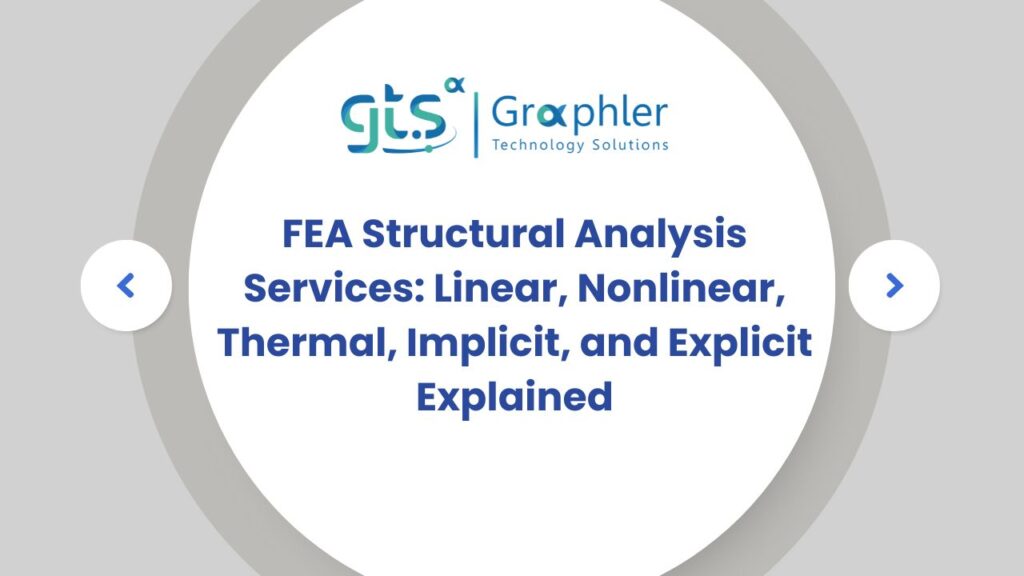- Introduction
- What is FEA (Finite Element Analysis)?
- Why FEA is Critical for Modern Engineering
- Linear vs. Nonlinear Structural Analysis
- Thermal Structural Analysis
- Implicit vs. Explicit Solvers: What’s the Difference?
- When to Use Each FEA Type
- Common Applications in Industry
- Key Benefits of FEA in Product Design
- Choosing the Right FEA Partner
- How We Deliver Accurate FEA Results
- Cost vs. Accuracy in Simulation
- Future Trends in Structural Simulation
- FAQs
1. Introduction
In today’s fast-paced engineering environment, accuracy and speed can make or break a project. Finite Element Analysis (FEA) plays a key role in predicting structural behavior, reducing prototypes, and optimizing performance. Whether you’re dealing with heavy machinery, consumer electronics, or high-temperature components, FEA offers a path to precision.
2. What is FEA?
Finite Element Analysis is a computerized method for predicting how a part or assembly reacts to real-world forces, vibration, heat, fluid flow, and other physical effects. It subdivides a large system into smaller, simpler parts called elements. The resulting equations are then solved to simulate the physical behavior of the system.
3. Why FEA is Critical for Modern Engineering
FEA helps reduce physical prototyping, lowers development costs, shortens design cycles, and ensures product reliability. It’s used across industries—from aerospace and automotive to civil structures and biomedical devices.
4. Linear vs. Nonlinear Structural Analysis
Linear Analysis assumes small deformations, constant stiffness, and a direct proportionality between loads and responses. It’s fast, cost-effective, and useful for preliminary design.
Nonlinear Analysis accounts for:
- Large deformations
- Material nonlinearity (plasticity, hyperelasticity)
- Contact and friction
This is crucial for realistic simulations where assumptions of linear behavior break down.
5. Thermal Structural Analysis
Thermal analysis evaluates how structures respond to temperature changes, heat generation, or thermal cycling. It’s especially useful in industries like power, aerospace, electronics, and metallurgy.
Coupled thermal-structural FEA helps assess:
- Thermal stress
- Thermal expansion
- Fatigue due to temperature gradients
6. Implicit vs. Explicit Solvers: What’s the Difference?
Implicit Solvers
- Good for static or quasi-static problems
- Require fewer time steps
- Stable for complex boundary conditions
Explicit Solvers
- Ideal for high-speed events like impact, crash, explosions
- Handle large deformations and contact easily
- Time-consuming but essential for dynamic analysis
Choosing the right solver can drastically affect result accuracy and computation time.
7. When to Use Each FEA Type
- Linear: Initial designs, small loads, rigid components
- Nonlinear: Rubber parts, snap-fit components, crash scenarios
- Thermal: Heat shields, electronic enclosures
- Explicit: Drop tests, crash simulations
- Implicit: Structural deflection, thermal loading, creep analysis
8. Common Applications in Industry
- Aerospace: Wing structure stress, thermal fatigue
- Automotive: Chassis impact analysis, engine heat dissipation
- Power: Boiler tubes, pressure vessels
- Consumer Goods: Drop simulation, packaging durability
- Civil: Earthquake resistance, structural load bearing
9. Key Benefits of FEA in Product Design
- Early failure prediction
- Design optimization
- Compliance with codes and standards
- Reduced development time
- Enhanced product reliability and safety
10. Choosing the Right FEA Partner
When outsourcing FEA, consider:
- Industry-specific experience
- Solver specialization (LS-DYNA, Abaqus, ANSYS, etc.)
- Certification and QA process
- Reporting transparency
- Speed and communication
11. How We Deliver Accurate FEA Results
At Graphler Technology Solutions, we use solvers based on the particular requirement backed by domain expertise in:
- Meshing optimization
- Material modeling
- Solver tuning
- Post-processing for design insights
Our multi-domain experience ensures reliable simulation outcomes that align with physical reality.
12. Cost vs. Accuracy in Simulation
While budget constraints exist, compromising on simulation accuracy can lead to product recalls, safety risks, or compliance failures. Investing in robust FEA pays off in:
- Lower lifetime cost
- Fewer redesigns
- Enhanced brand trust
13. Future Trends in Structural Simulation
- AI-assisted simulation
- Cloud-based solvers
- Digital twins
- Real-time feedback loops
- Multiphysics coupling (electro-thermal-mechanical)
Staying ahead in FEA capabilities ensures product leadership and innovation.
14. FAQs
Q1: What software do you use for FEA?
We use industry-leading tools like ANSYS, Abaqus, COMSOL, and LS-DYNA, selected based on the application.
Q2: Can I get both linear and nonlinear analysis?
Absolutely. We offer tailored packages depending on project complexity and design maturity.
Q3: What industries do you serve?
We work with power, aerospace, manufacturing, automotive, and consumer goods sectors.
Q4: Do you provide consulting or end-to-end design validation?
Yes, we offer complete design-validation-reporting cycles, along with actionable insights.
Conclusion
FEA structural analysis is more than a simulation—it’s a vital engineering decision-making tool. From early concept designs to safety-critical validation, our team helps you unlock better performance, lower risk, and faster market entry.
Graphler Technology Solution provides Finite Element Analysis Services India which includes stress analysis services and structural design services , we have a experienced team with 10 yrs of experience in industrial knowledge. Partnering up with the best structural analysis services provider or top product design companies will help you to discover new ideas.


